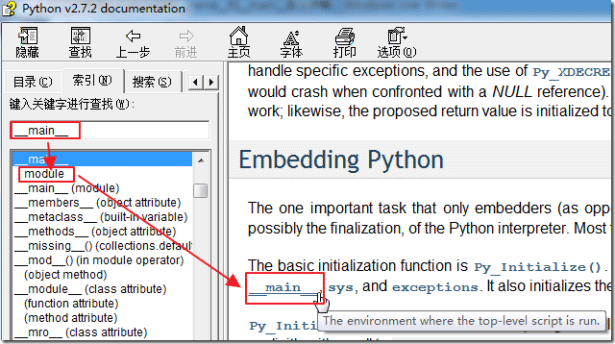您好,登录后才能下订单哦!
这篇文章主要介绍“python特殊属性及方法怎么用”的相关知识,小编通过实际案例向大家展示操作过程,操作方法简单快捷,实用性强,希望这篇“python特殊属性及方法怎么用”文章能帮助大家解决问题。
在python中,以单下划线开头的(_a)的代表不能直接访问的类属性,需通过类提供的接口进行访问,不能用“from xxx import *”而导入,“单下划线” 开始的成员变量叫做保护变量,意思是只有类对象和子类对象自己能访问到这些变量;以双下划线开头的(_ _a)代表类的私有成员,意思是只有类对象自己能访问,连子类对象也不能访问到这个数据;以双下划线开头和结尾的(_ _a_ _)代表python里特殊方法专用的标识,如 _ _init_ _()代表类的构造函数。
如果是一个对象的调用,则表示类的名称,而不是表示对象的名称;如果当前模块被直接执行(主模块),_ _ name _ _ 存储的是_ _ main _ _ ;如果当前模块是被调用的模块(被导入),则_ _ name _ _存储的是py文件名(模块名称)。
1、表示对象的名称
>>> class A(object): a = 1 def __init__(self): self.b = 'c' >>> a = A() >>> A.__name__ 'A' >>> a.__name__ Traceback (most recent call last): File "<pyshell#7>", line 1, in <module> a.__name__ AttributeError: 'A' object has no attribute '__name__'
2、表示_ _ main _ _函数的名称,也就是程序的入口,类似于java中main函数

>>> __name__ '__main__'
3、如果当前模块被其他模块调用,则是当前模块的名称
demo1.py
print(__name__)
demo2.py
import demo1
运行demo2.py文件后,得到的结果为:
demo1
_ _ bases _ _ 表示类的所有基类;_ _ base _ _ 输出类继承的第一个父类(类的基类); _ _ mro _ _ 输出类的层次结构。
>>> class A: def __init__(self): self.a = 2 >>> class B(A): def __init__(self): super().__init__() self.b = 3 >>> class C(A): def __init__(self): super().__init__() self.c = 4 >>> class D(B, C): def __init__(self): super().__init__() self.d = 5 >>> D.__bases__ (<class '__main__.B'>, <class '__main__.C'>) >>> D.__base__ <class '__main__.B'> >>> D.__mro__ (<class '__main__.D'>, <class '__main__.B'>, <class '__main__.C'>, <class '__main__.A'>, <class 'object'>)
表示对象的类型,相当于type()函数。
>>> class A: def __init__(self): self.a = 2 >>> a = A() >>> a.__class__ <class '__main__.A'>
表示对象和类的一些属性,用一个字典存储起来。
>>> class A:
a = 1
b = 2
def __init__(self):
self.c = 3
self.d = 4
>>> a = A()
>>> a.__dict__
{'c': 3, 'd': 4}
>>> A.__dict__
mappingproxy({'__module__': '__main__', 'a': 1, 'b': 2, '__init__': <function A.__init__ at 0x000001CD66F6B8B0>, '__dict__': <attribute '__dict__' of 'A' objects>, '__weakref__': <attribute '__weakref__' of 'A' objects>, '__doc__': None})表示类的所有直接子类。
>>> class A: def __init__(self): self.a = 2 >>> class B(A): def __init__(self): super().__init__() self.b = 3 >>> class C(A): def __init__(self): super().__init__() self.c = 4 >>> class D(B, C): def __init__(self): super().__init__() self.d = 5 >>> C.__subclasses__() [<class '__main__.D'>] >>> A.__subclasses__() [<class '__main__.B'>, <class '__main__.C'>]
_ _ new _ _ ()是一个静态方法,用于根据类型创建实例。Python在调用 _ _ new _ _ ()方法获得实例后,会调用这个实例的_ _ init _ _ ()方法,然后将最初传给 _ _ new _ _ ()方法的参数都传给 _ _ init _ _ ()方法。
_ _ init _ _ ()是一个实例方法,用来在实例创建完成后进行必要的初始化,该方法必须返回None。Python不会自动调用父类的 _ _ init _ _ ()方法,这需要额外的调用:
super(C, self). _ _ init _ _ ()
_ _ new _ _ ()至少要有一个参数cls,代表要实例化的类,此参数在实例化时由Python解释器自动提供;_ _ new _ _ ()必须要有返回值,返回实例化出来的实例,可以return父类new出来的实例,或直接是object的new出来的实例。
>>> class A(object):
def __new__(cls, *args, **kwargs):
print("__new__")
instance = object.__new__(cls)
# 或者
# instance = super().__new__(cls)
return instance
def __init__(self):
print("__init__")
>>> a = A()
__new__
__init__在GC之前,Python会调用这个对象的 _ _ del _ _ ()方法完成一些终止化工作。如果没有 _ _ del _ _ ()方法,那么Python不做特殊的处理;此外,Python无视_ _ del _ _ ()方法的返回值;Python不会自动调用父类的 _ _ del _ _ ()方法,除非显式调用;定义了 _ _ del _ _ ()方法的实例无法参与到循环GC中,所以对于这样的实例应该避免循环引用;try/finally语句或with语句可能是比_ _ del _ _()更好的方式。
>>> class A(object):
def __new__(cls, *args, **kwargs):
print("__new__")
instance = super().__new__(cls, *args, **kwargs)
return instance
def __init__(self):
print("__init__")
def __del__(self):
print("__del__")
>>> a = A()
__new__
__init__
>>> del a
__del___ _ repr _ _ ()是一个 ”自我描述“ 的方法,也是Python类中的一个特殊方法,由object对象提供,由于object提供的这个 _ _ repr _ _ 方法总是返回一个对象, ( 类名 + obejct at + 内存地址 ),这个值并不能真正实现自我描述的功能,如果你想在自定义类中实现 “自我描述” 的功能,那么必须重写 _ _ repr _ _ 方法。_ _ repr _ _ ()方法返回的字符串主要是面向解释器的。
>>> class A(object): def __repr__(self): return "this is a class A" >>> a = A() >>> a this is a class A >>> print(a) this is a class A >>> str(a) 'this is a class A'
_ _ str _ _ ()与_ _ repr _ _ ()返回的详尽的、准确的、无歧义的对象描述字符串不同,_ _ str _ _ ()方法只是返回一个对应对象的简洁的字符串表达形式。如上代码所示,当_ _ str _ _ ()缺失时,Python会调用_ _ repr _ _ ()方法。
>>> class A(object): def __str__(self): return "this is a class A" >>> a = A() >>> a <__main__.A object at 0x000001CF8C8F9640> >>> print(a) this is a class A >>> str(a) 'this is a class A'
实际上_ _ str _ _ ()只是覆盖了_ _ repr _ _ ()以得到更友好的用户显示。Python内置的str()函数,print(x)语句,都会调用对象的_ _ str _ _()方法。
>>> class A(object): def __repr__(self): return "class A" def __str__(self): return "this is a class A" >>> a = A() >>> a class A >>> print(a) this is a class A >>> str(a) 'this is a class A'
定义了该方法的对象可以像函数那样被调用,因此被称为可调用对象。
>>> class A(object): def __init__(self): self.a = 2 def __call__(self, b, *args, **kwargs): c = b + self.a return c >>> a = A() >>> a(3) 5
当两个对象x、y分别进行x<y、x<=y、x>y、x>=y、x==y和x!=y运算时,会调用对应的函数。
>>> class A(object):
def __init__(self, b):
self.b = b
def __lt__(self, other):
print("__lt__")
return self.b < other.b
>>> c = A(3)
>>> d = A(4)
>>> c < d
__lt__
True三种情形会调用__hash__()方法:1. 内置的hash()方法,2.作为字典的键时,3.作为集合的成员时;_ _ hash _ _ ()方法应该返回一个32位长的整数,对与同一个对象,hash()方法应该总是返回相同的值;对于 x == y ,即使二者不属于相同的类型,只要他们是可哈希的(hashable),都应该确保得到 hash(x) == hash(y) ;
>>> class A(object): def __init__(self, n): self.n = n def __eq__(self, other): return self.n == other.n def __hash__(self): return random.randint(0, 10) >>> a = A(3) >>> b = A(3) >>> a == b True # 虽然a == b返回结果为True,但是hash(a)和hash(b)返回结果不一样,所以不能说这两个对象是相同的。 >>> hash(a) 3 >>> hash(b) 5
_ _ eq _ _()正确的用法:
class A(object): def __init__(self, n): self.n = n def __hash__(self): return hash(id(self)) def __eq__(self, other): if isinstance(other, self.__class__): return hash(id(self))==hash(id(other)) else: return False
通过_ _ hash _ _ 返回一个int值,用来标记这个对象。对于类而言,如果没有实现_ _ eq _ _ ()和 _ _ hash _ _ ()函数,那么会自动继承object._ _ hash _ _()。
关于“python特殊属性及方法怎么用”的内容就介绍到这里了,感谢大家的阅读。如果想了解更多行业相关的知识,可以关注亿速云行业资讯频道,小编每天都会为大家更新不同的知识点。
免责声明:本站发布的内容(图片、视频和文字)以原创、转载和分享为主,文章观点不代表本网站立场,如果涉及侵权请联系站长邮箱:is@yisu.com进行举报,并提供相关证据,一经查实,将立刻删除涉嫌侵权内容。